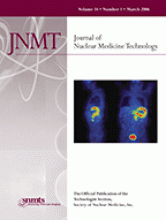Abstract
Recently, the use of 18F-FDG PET has progressed rapidly as a standard diagnostic imaging tool in many types of cancer. The purpose of this study was to evaluate the patterns and prevalence of muscle uptake as a result of muscle activity shortly before the 18F-FDG injection or during the uptake phase. Methods: From October 2002 to October 2003, whole-body 18F-FDG PET scans (4-min emission and 3-min transmission per bed position) were performed on 1,164 patients with known or suspected malignancy. Images were acquired on a dedicated PET scanner 45−60 min after an intravenous injection of a weight-adjusted dose of 7.4 MBq/kg (0.2 mCi/kg) with a maximum of 925 MBq (25 mCi) 18F-FDG. A log of any nonphysiologic muscle activity during the uptake phase or reported excessive muscle activity the day before scanning was kept by the technologists. In addition, PET scans were reviewed retrospectively to evaluate any undesirably increased muscle uptake. Results: A total of 146 of 1,164 patients (12.5%) had excessively increased muscle uptake detected on the PET scan that corresponded to the technologists' notes of muscle activity during the uptake phase or before 18F-FDG injection. Encountered patterns of muscle uptake due to muscle activity included uptake in neck, secondary to neck strain from being on a stretcher; masseter, secondary to chewing gum; vocal cords, secondary to speaking; chest wall, secondary to labored breathing; forearms and hands, secondary to reading; and lower extremities, secondary to nervous tapping of the feet. Conclusion: Undesirably increased physiologic muscle uptake is frequently encountered on 18F-FDG PET scans. In this study, 12.5% of patients were affected. It is prudent to instruct the patient to avoid any excessive physical activity at least 48 h before injection as well as to not exert muscle activity during the uptake phase. Furthermore, a record should be kept by the technologist of any observed excessive muscle activity during the uptake phase and reported to the reading physician—thus, eliminating a potential source of false-positive findings on interpreting PET scans.







